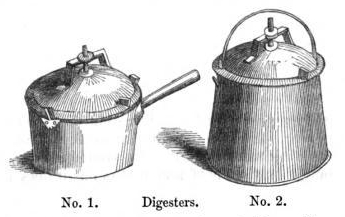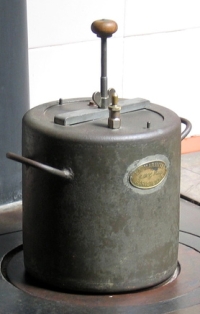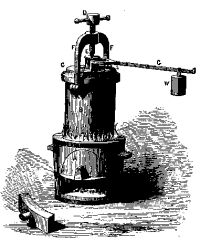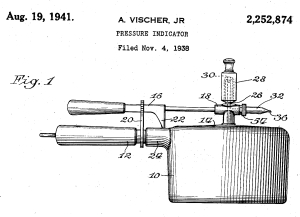-
History of:
- Resources about:
- More:
- Baby walkers
- Bakehouses
- Bed warmers
- Beer, ale mullers
- Besoms, broom-making
- Box, cabinet, and press beds
- Butter crocks, coolers
- Candle snuffers, tallow
- Clothes horses, airers
- Cooking on a peat fire
- Drying grounds
- Enamel cookware
- Fireplaces
- Irons for frills & ruffles
- Knitting sheaths, belts
- Laundry starch
- Log cabin beds
- Lye and chamber-lye
- Mangles
- Marseilles quilts
- Medieval beds
- Rag rugs
- Rushlights, dips & nips
- Straw mattresses
- Sugar cutters - nips & tongs
- Tablecloths
- Tinderboxes
- Washing bats and beetles
- Washing dollies
- List of all articles
Subscribe to RSS feed or get email updates.
Thomas Small & Co.....Kitchen Furniture.....Kitchens, or Perpetual boilers, with Brass Cranes; Digesters all sizes; Sauce Pans ditto, Fish Kettles and Strainers...
Advertisement in The Scotsman, 1836
Pressure Perfect from Amazon.com
or from Amazon UK
The great importance and utility of this valuable utensil, in producing a larger quantity of wholesome and nourishing food by a much cheaper method than has ever been hitherto obtained, cannot be too earnestly recommended to those who make economy an object of their attention. ... Care must be taken, in filling the digester, to leave room enough for the steam to pass off through the valve at the top of the cover. This may be done by filling the digester only three parts full of water and bruised bones or meat, which it is to be noticed are all put in together.
Murray's Modern Cookery Book, by a lady, c1851
Pressure Cookers for Dummies from Amazon.com
or from Amazon UK
Community canning centers and clubs will have a better chance than individual families of obtaining pressure cookers, for 150,000 of which the Department of Agriculture has allocated materials...
New York Times, April 23 1943
Cooking under pressure
Steam digesters, pressure cookers
 If you try to live a greener life,
wasting less, cutting back on energy, you may re-discover ancient, simple domestic
routines that are a source of pleasure - like walking into a sunny garden to put
your laundry out to dry. Pressure cooking doesn't
have quite the same feel-good levels, and yet it can save a lot of energy, and
may make some people think nostalgically of Grandma's kitchen.
If you try to live a greener life,
wasting less, cutting back on energy, you may re-discover ancient, simple domestic
routines that are a source of pleasure - like walking into a sunny garden to put
your laundry out to dry. Pressure cooking doesn't
have quite the same feel-good levels, and yet it can save a lot of energy, and
may make some people think nostalgically of Grandma's kitchen.
Of course the pressure cooker isn't ancient. It was a 17th century invention: cutting-edge technology, with the unattractive name of digester. For nearly a hundred and fifty years, it kept that name. Its inventor, Denis Papin, thought it might help the poorest people to extract nutrition from bones, but early models were far too expensive for people who really needed to save money and cooking fuel. In the 19th century, the people who were most interested in these digesters, apart from scientists, were military men who wanted a quick way of producing meals in camp, and industrial inventors looking into canning or beef extract production.
 In the UK, there were
digesters being sold as "kitchen furniture" from the 1830s onward,
and people put the case for their "economy" in producing "nutritious" food from
bones. But they would have cost a poor Victorian family a couple of days' wages
and presumably were sold to more prosperous households.
In the UK, there were
digesters being sold as "kitchen furniture" from the 1830s onward,
and people put the case for their "economy" in producing "nutritious" food from
bones. But they would have cost a poor Victorian family a couple of days' wages
and presumably were sold to more prosperous households.
[The picture shows two digesters;] both, however, on the same principle, and made of cast-iron; No. 1 being of the smaller size, and No. 2 for any quantity from half a gallon upwards ; the price being, according to the size, from 12 shillings to 30 shillings, and for the smaller sort half the former sum.
Murray's Modern Cookery Book, by a lady, c1851
 It wasn't till the 20th century
that steam pressure cookers appeared in a good number of ordinary home kitchens.
To begin with they looked dauntingly un-domestic: hefty contraptions with gauges,
valves, and heavy-duty explosion-proof construction, like the one above right. In
the USA they were bought by people who did a lot of home canning. The name "pressure
cooker" became established as an alternative to "steam digester", "continuous pressure
cooker" etc.
It wasn't till the 20th century
that steam pressure cookers appeared in a good number of ordinary home kitchens.
To begin with they looked dauntingly un-domestic: hefty contraptions with gauges,
valves, and heavy-duty explosion-proof construction, like the one above right. In
the USA they were bought by people who did a lot of home canning. The name "pressure
cooker" became established as an alternative to "steam digester", "continuous pressure
cooker" etc.
Then, in the 1930s they began to look more like other cookware, in time for their popularity during World War Two. During the war the US government wanted to encourage food preserving, and supported manufacture and sales of pressure cookers to community canning centres. Across the Atlantic, there were no spare resources for manufacturing new kitchen equipment, but people who already owned pressure cookers were able to conserve fuel, and make meat scraps edible.
After the war, a few cookbooks devoted to pressure cookery were published. Another wave of recipes for pressure cooking appeared with the 1970ish interest in wholefoods. The high temperatures possible with steam pressure make it easier to cook soybeans and some other ingredients associated with wholefood/vegetarian cooking.
Pressure cookers are popular in mountainous Tibet. At high altitudes they make it possible to get water boiling.
Dates - partial timeline
- 1679 Denis Papin shows his digester to the Royal Society in London (See picture below left.)
- 1681 Papin publishes A New Digester or Engine for Softening Bones
- 1682 Supper cooked in a digester is served to London intellectuals. (See quote below)
- c1800 Nicolas Appert invents canning: a new way of preserving food using an autoclave, a "cooker" with steam pressure, like Papin's digester
- 1830s Digesters on sale in the UK
- 1874 A.K. Shriver is issued with crucial US patent for canning apparatus using steam pressure
- 1914 First record of the name "pressure cooker" - Oxford English Dictionary
- 1930s Pressure cookers start to look like "normal" domestic saucepans. (See drawing below right.) Alfred Vischer had been filing patents for easy-to-seal pressure cookers since 1921, and his Flex-Seal cooker started to get press attention in 1939. (Sometimes mistakenly spelled Vischler)
- Early 1940s - pressure cookers used for canning supported by US Victory Garden movement

1682, 12th April: I went this afternoon with several of the Royal Society to a supper which was all dressed, both fish and flesh, in Monsieur Papin's digestors, by which the hardest bones of beef itself, and mutton, were made as soft as cheese, without water or other liquor, and with less than eight ounces of coals, producing an incredible quantity of gravy; and for close of all, a jelly made of the bones of beef, the best for clearness and good relish, and the most delicious that I had ever seen, or tasted. We eat pike and other fish bones, and all without impediment; but nothing exceeded the pigeons...
Diary and Correspondence of John Evelyn, F.R.S., published 1862

 21 February 2008
21 February 2008
You may like our new sister site Home Things Past where you'll find articles about antiques, vintage kitchen stuff, crafts, and other things to do with home life in the past. There's space for comments and discussion too. Please do take a look and add your thoughts. (Comments don't appear instantly.)
For sources please refer to the books page, and/or the excerpts quoted on the pages of this website, and note that many links lead to museum sites. Feel free to ask if you're looking for a specific reference - feedback is always welcome anyway. Unfortunately, it's not possible to help you with queries about prices or valuation.




